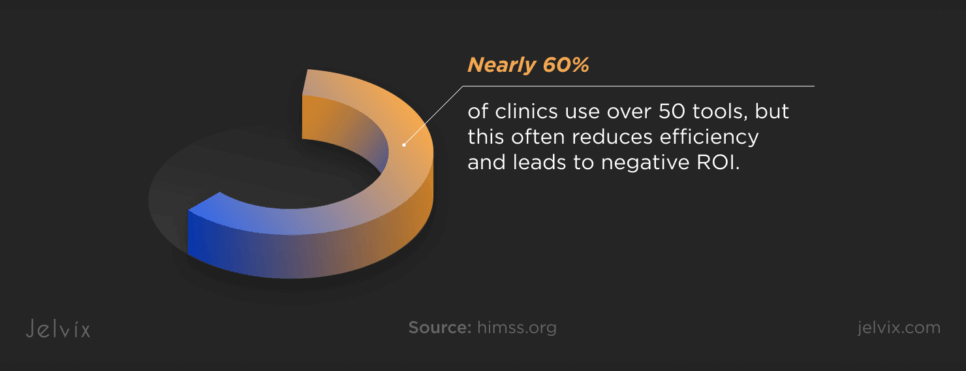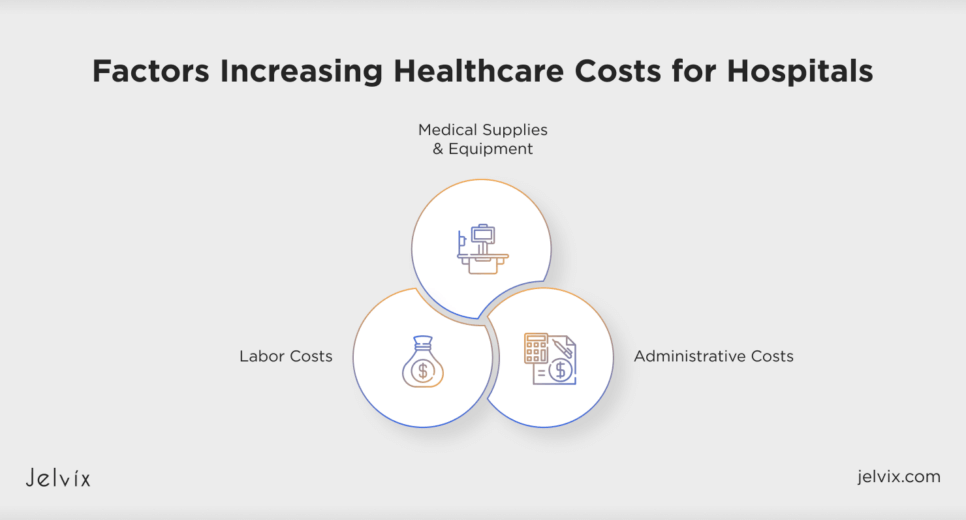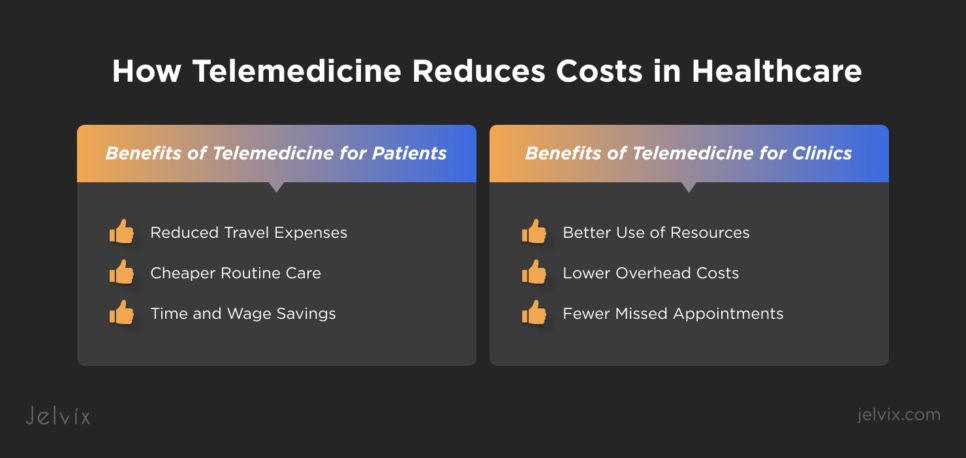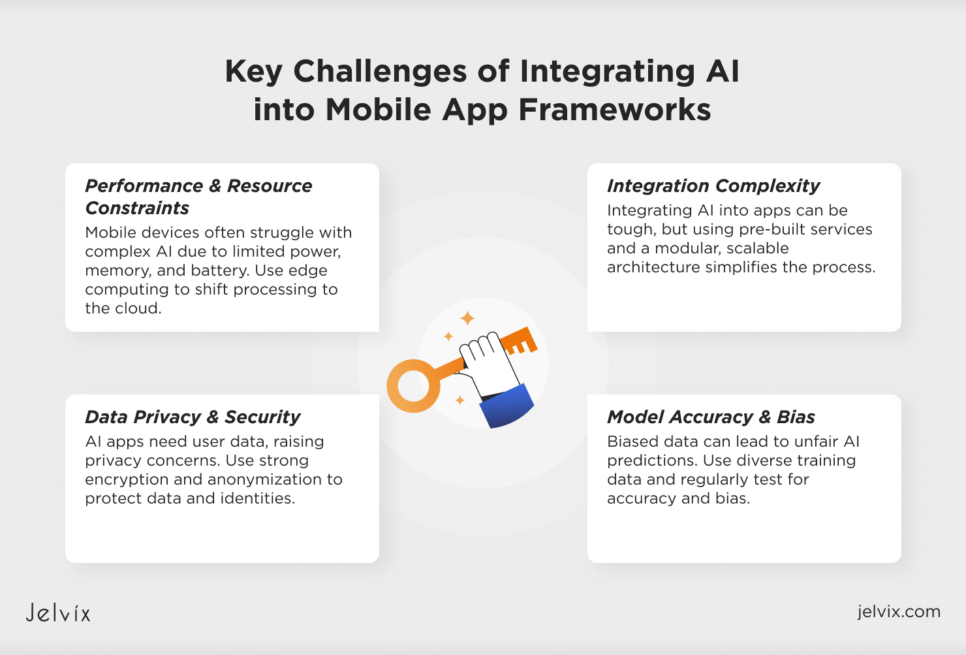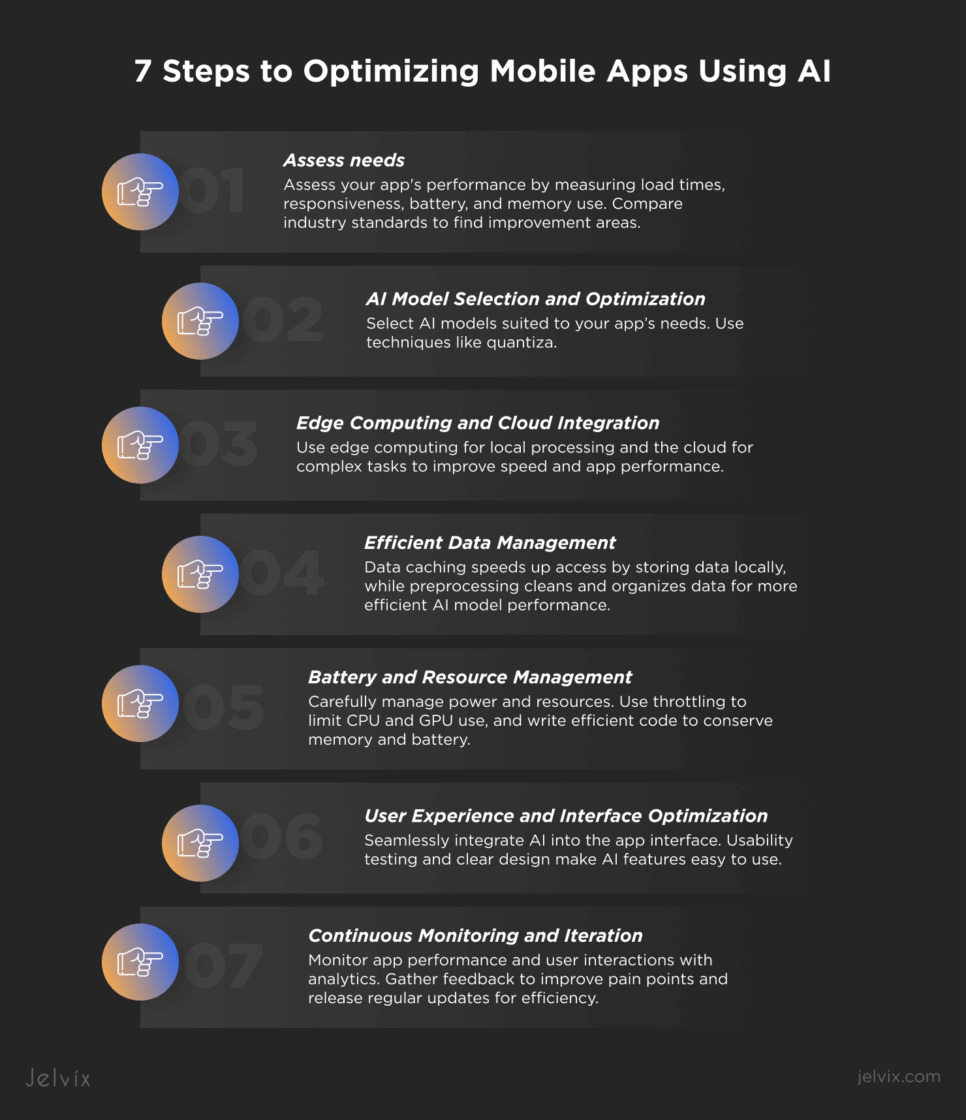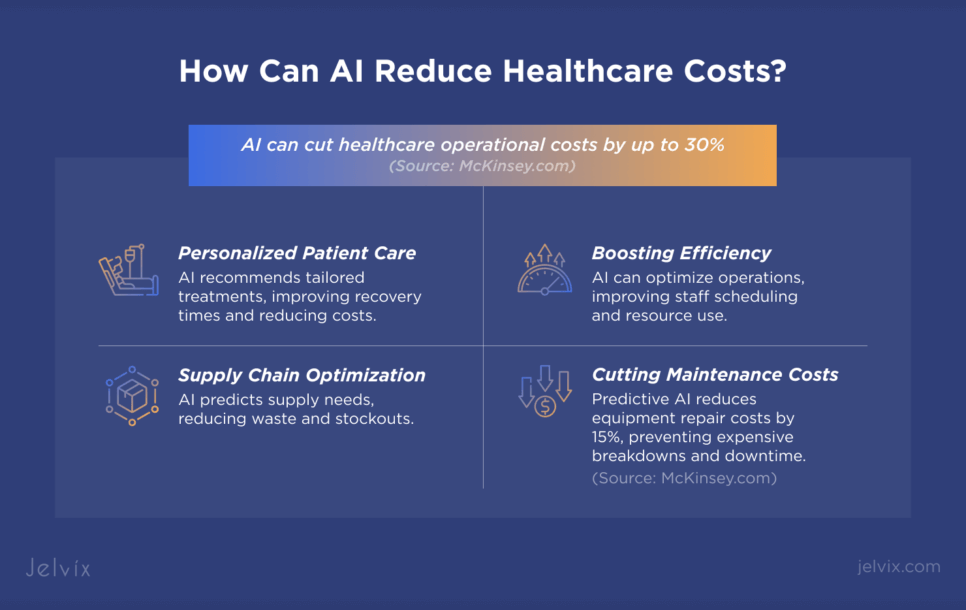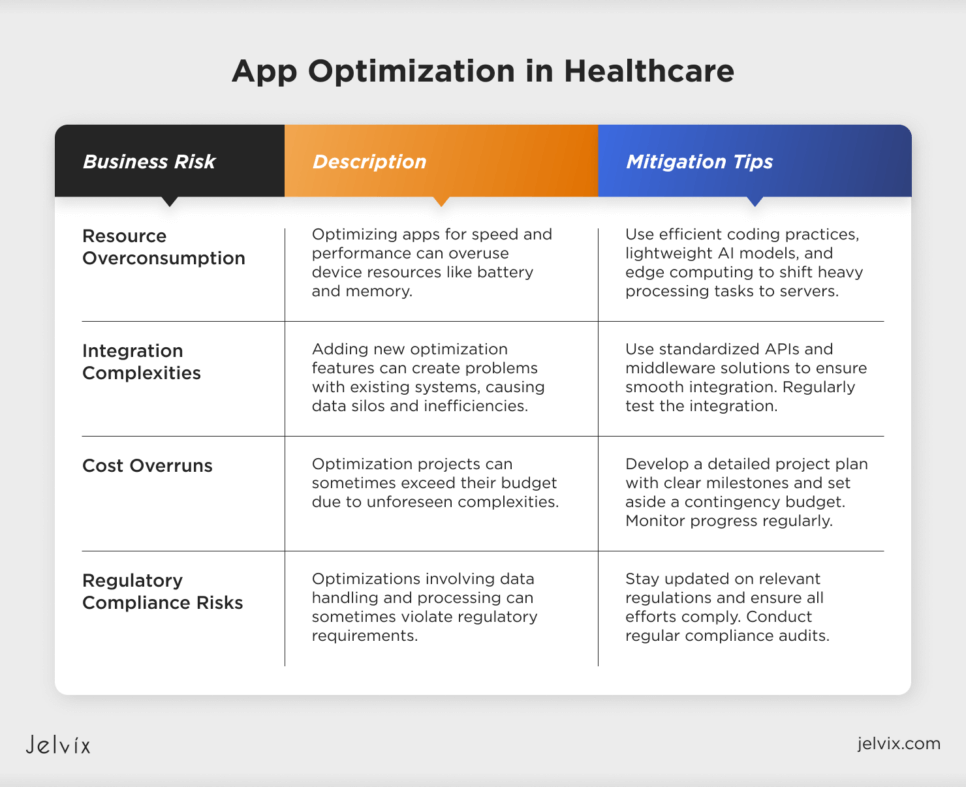Efficiency is becoming a whopping concern in healthcare as many providers develop and implement numerous digital solutions that are difficult to manage.
Nearly 60% of clinics use more than 50 different tools, including mHealth apps, to handle clinical and operational tasks. But very often, this results in negative ROI and compromised efficiency instead of enhanced operations.
If you want to use medical apps to enhance your processes and keep costs as low as possible, read this article. You’ll discover key strategies to boost the performance of your healthcare applications and ways to use AI and machine learning to optimize your digital solutions.
Factors Increasing Healthcare Costs for Hospitals
Healthcare is getting more expensive for clinics and patients due to several factors. Understanding them can help you develop strategies to manage these costs effectively and improve your healthcare business process.
Labor Costs
Labor costs, including salaries, wages, and benefits for healthcare workers, account for about 60% of healthcare costs. The high demand for skilled medical professionals, especially in areas with shortages, leads to the need for higher salaries and often involves paying overtime.
Medical Supplies and Equipment
It’s important that clinics have enough supplies like syringes and gloves for daily operation. What’s more, they need to have modern equipment, such as MRI machines and surgical robots, to provide quality care to patients. All these add to the cost of running a hospital.
Administrative Costs
Operating a clinic involves significant administrative expenses that include billing, coding, insurance claims, and staying compliant with regulations. What’s more, you need experienced staff to manage these costs, which drives up operational expenses.
How Telemedicine Lowers Healthcare Costs
Telemedicine is a cost-effective solution for both patients and clinics. It reduces expenses related to travel, appointment costs, and overhead while improving access to care and making healthcare more efficient.
Benefits of Telemedicine for Patients
Patients can greatly benefit from telemedicine, saving time, money, and efforts related to visiting a hospital.
Reduced Travel Expenses
Telemedicine allows patients to connect with their doctors from home, eliminating the need to spend money on gas, public transport, or parking. This can mean significant savings for those who live far from medical facilities.
Cheaper Routine Care
Virtual doctor visits are generally less expensive than in-person appointments. Because healthcare providers don’t need to cover the costs of a physical space, they can offer services at a lower price.
Time and Wage Savings
Telemedicine makes it easier for patients to fit appointments into their schedules. This flexibility helps them avoid taking time off and losing income, making it easier to manage their health without sacrificing work.
Benefits of Telemedicine for Clinics
Telemedicine apps can offer affordable solutions for clinics to help them offer care to a broader patient base and reduce medical costs.
Better Use of Resources
Telemedicine helps clinics operate more efficiently by reducing the need for large physical spaces like waiting rooms. Because virtual appointments usually take less time, clinics can see more patients each day, making better use of their resources.
Lower Overhead Costs
With less need for physical space, clinics can save money on rent, utilities, and maintenance. These savings can be reinvested in business development or offered as discounts to patients.
Fewer Missed Appointments
Missed appointments can be costly for clinics, but telemedicine reduces this problem. Patients are more likely to keep their appointments when they can schedule them from the comfort of their own homes.
Discover how a Remote Patient Monitoring solution can enhance effectiveness in patient treatment by enabling real-time data tracking, improving care, and optimizing medical processes.
Mobile App Optimization for Clinics: the Role of AI
Experts estimate that AI can save the healthcare industry about USD 360 billion annually. Updating your medical app with AI can make it more efficient and help your clinic provide more care possibilities to patients.
Enhanced Decision Support
Since AI can analyze and present data in a comprehensible way, doctors get a better understanding of patients’ health conditions. What’s more, AI-backed apps can stimulate patients to take better care of themselves by sending timely medication reminders and personalized healthcare tips.
Smart Data Processing and Analytics
In addition to processing various kinds of patient data, AI apps can do it with high accuracy. Thanks to advanced machine learning algorithms, AI gets data from multiple sources and offers quick insights to healthcare workers.
Personalization
AI helps customize the experience for each user by learning from their interactions and preferences. By analyzing how users behave, AI can tailor the app’s interface, recommendations, and content to fit each person’s specific needs.
Key Challenges of Integrating AI into Mobile App Frameworks
Integrating AI into mobile apps can bring fantastic results, but it also comes with a set of challenges that clinics need to address.
Performance and Resource Constraints
Mobile devices may lack the processing power, memory, and battery life of computers and servers, causing issues with complex AI algorithms. Consider using edge computing to shift heavy processing to the cloud.
Data Privacy and Security
AI apps require significant user data, raising privacy and security concerns. Use strong encryption to protect data during transmission and storage and anonymize it with encryption algorithms to protect user identities.
Integration Complexity
Adding AI to existing app frameworks can be tricky and time-consuming. However, you can ease the process by using pre-built AI services and libraries. What’s more, a modular and scalable architecture can help integrate AI without major restructuring.
Model Accuracy and Bias
AI models trained on biased data can make unfair or incorrect predictions. Use diverse and representative training data and regularly test AI models for accuracy and bias.
AI-Driven Healthcare Optimization: 7 Steps for Mobile Apps
Optimizing mobile apps using AI involves several important steps to ensure the app runs smoothly and efficiently while providing a great user experience.
1. Initial Assessment and Benchmarking
First, assess your app’s current performance by collecting data on load times, responsiveness, battery usage, and memory consumption. Compare this data to industry standards or similar apps to identify areas for improvement.
2. AI Model Selection and Optimization
Choose AI models that meet your medical app’s needs. Techniques like quantization and pruning help reduce model size for better efficiency. Use specialized hardware like GPUs or AI accelerators to boost performance.
3. Edge Computing and Cloud Integration
Reduce the load on mobile devices by processing parts of your data locally (edge computing) and more complex tasks in the cloud. This approach speeds up data processing and ensures smooth app performance.
4. Efficient Data Management
Data caching stores frequently accessed data locally, making it quicker to retrieve. Data preprocessing involves cleaning and organizing data before it’s used by AI models, which helps them run more efficiently.
5. Battery and Resource Management
Manage power and resource usage carefully. Resource throttling limits CPU, GPU, and other resources during high-demand periods to prevent overheating and battery drain. Write efficient code to minimize unnecessary processes, conserving memory and battery life.
6. User Experience and Interface Optimization
Integrate AI features seamlessly into the app’s interface. Conduct usability testing to ensure users can easily interact with these features. A user-friendly design and clear instructions can make AI-powered features accessible and easy to use.
7. Continuous Monitoring and Iteration
Use analytics tools to monitor the app’s performance and user interactions. Collect user feedback to identify pain points and areas for improvement. Regular updates based on this data help keep the app efficient and user-friendly.
Hospital Inventory Software: Using AI To Resolve Key Performance Issues
When we think about AI in healthcare, the focus often switches to its role in improving patient care. However, AI’s influence goes beyond tools for monitoring and diagnosing. Your clinic’s efficiency also relies on smooth operation management.
This is when hospital inventory software comes into play, helping ensure that medical equipment, supplies, and medications are on hand when needed. Yet, these tools may involve performance issues that could disrupt hospital operations.
Slow Response Times
When hospital inventory software is slow, it can make it harder for staff to do their jobs efficiently. AI can help by predicting high-demand times and automatically adjusting the system’s performance to handle increased workloads. It can distribute the workload across multiple servers and cache frequently accessed data to speed up response times.
Inaccurate Inventory Data
Incorrect inventory data can lead to running out of supplies or overstocking. AI can tackle this issue by continuously monitoring inventory levels in real time and using machine learning algorithms to predict usage patterns.
Integration Issues
Integration problems can create data silos and inefficiencies. AI can ease the integration by using standardized APIs that seamlessly connect the inventory software with EHRs and medical billing systems. Regular integration testing supported by AI-driven analytics can identify and resolve issues, ensuring all systems work together efficiently.
Learn how to build an efficient inventory management system, covering key steps, technologies, and best practices to streamline operations and optimize inventory control.
Reducing Healthcare Costs through Technology and Adding AI Features
AI is known to enhance medical solutions with advanced features and real-time data processing. However, it can also help clinics cut operational costs and improve their financial health.
Personalizing Patient Care
AI can analyze patient data and recommend treatment based on the info it receives. This targeted care approach can lead to quicker recovery times and reduced treatment costs.
Boosting Operational Efficiency
AI can analyze vast amounts of data helping spot inefficiencies in clinical operations. For instance, AI-powered predictive analytics can anticipate patient admissions, allowing hospitals to optimize staff schedules and allocate resources effectively.
Optimizing Supply Chain Management
AI can predict when your clinics will need supplies and identify the best time to order them. As a result, you can avoid stockouts and overstocking, keeping all suppliers on the optimal level and reducing waste.
Reducing Equipment Maintenance Costs
AI predicts when medical equipment might fail by analyzing usage patterns and performance data. This predictive maintenance approach allows clinics to perform maintenance before equipment breakdowns occur, reducing the costs associated with emergency repairs and downtime.
App Optimization in Healthcare: Business Risks To Know and Tips To Mitigate Them
Optimizing app performance can greatly improve efficiency, but it also imposes several risks that require prompt addressing.
Resource Overconsumption
Optimizing apps for speed and performance can overuse device resources like battery and memory. To avoid this, use efficient coding practices, lightweight AI models, and edge computing to shift heavy processing tasks to servers.
Integration Complexities
Adding new optimization features can create problems with existing systems, causing data silos and inefficiencies. To avoid this, use standardized APIs and middleware solutions to ensure smooth integration. Regularly test the integration to catch and fix issues early.
Cost Overruns
Optimization projects can sometimes exceed their budget due to unforeseen complexities. Develop a detailed project plan with clear milestones and set aside a contingency budget for unexpected expenses. Regularly monitor progress to stay on track financially.
Regulatory Compliance Risks
Optimizations involving data handling and processing can sometimes violate regulatory requirements, leading to legal issues. Stay updated on relevant regulations and ensure all optimization efforts comply with them. Also, conduct regular compliance audits to identify and address any potential issues.
3 Apps Optimized with AI: Real-World Cases
Numerous medical apps have already benefited from AI optimization. Looking through some real-world examples can help you understand the key advantages of this process.
Ada Health
Ada is an AI-powered app that helps users understand their symptoms and manage their health. The app’s AI analyzes reported data and provides possible condition suggestions, making the diagnostic process quicker and more accurate.
Babylon Health
Babylon Health is a telemedicine app that enhances virtual consultations, symptom checks, and health monitoring with AI. It uses ML to analyze symptoms and offer precise diagnostic recommendations, improving the efficiency of virtual care.
SkinVision
SkinVision helps users detect early signs of skin cancer through AI-powered image analysis. The app offers personalized tips and educational content based on the analysis, helping users understand their skin health.
How Jelvix Helps Build AI-Backed Healthcare Solutions
It’s not enough to integrate a mobile app into your healthcare settings to boost clinical efficiency. You also need to optimize its performance based on user feedback and market research to reduce associated costs and mitigate possible business risks.
At Jelvix, we provide healthcare software development and app integration services to help clinics improve their operations and manage costs. Our expert team uses AI and ML to create custom solutions tailored to the specific needs of healthcare facilities.
If you seek to develop a medical app from scratch or need to optimize the existing one, our team is here to help. Contact our experts for a personalized consultation based on your clinic’s unique needs.
Ready to enhance your healthcare tech?
Partner with us to drive innovation. Let’s talk today!


